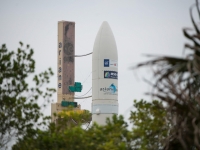Technology
Europe into orbit a new weather satellite
The MSG-4 will serve European agencies
The MSG-4 satellite is the eleventh of the Meteosat series and has been attached to the Ariane 5 launcher, which is ready for takeoff. The launch is scheduled for 21:42 GMT (23:42 Central European Time) on Wednesday from the satellite launch base in French Guiana. The Ariane 5 will also orbit another satellite, the Brazilian Star One C4 communications.
In geostationary orbit 36,000 km above the equator, the Meteosat satellites (Meteosat-7, -8, -9 and -10) operate over Europe and Africa. Meteosat-10 (launched from the Guiana Space Centre in Kourou in 2012) is the prime operational geostationary satellite, positioned at 0 degrees and providing full disc imagery every 15 minutes. Meteosat-9 (launched on 2005) provides the Rapid Scanning Service, delivering more frequent images every five minutes over parts of Europe, Africa and adjacent seas.
Meteosat-8 (launched in 2002) serves as a back up to both spacecraft. Meteosat-7 (launched in 1997) is the last of the first generation of Meteosat satellites and operates over the Indian Ocean, filling a data gap over the region until it is de-orbited in 2017. The MSG-4 satellite is due to be launched in July 2015 and will be stored in orbit, until required.
The primary role of the Meteosat satellites is to help detect and forecast rapidly developing high impact weather, such as thunderstorms or fog, up to six hours ahead. Nowcasting and very short range forecasts “” up to six hours “” are vital for the safety of life, property and infrastructure and rely on very frequent, detailed images of the atmosphere.
Liability for this article lies with the author, who also holds the copyright. Editorial content from USPA may be quoted on other websites as long as the quote comprises no more than 5% of the entire text, is marked as such and the source is named (via hyperlink).






